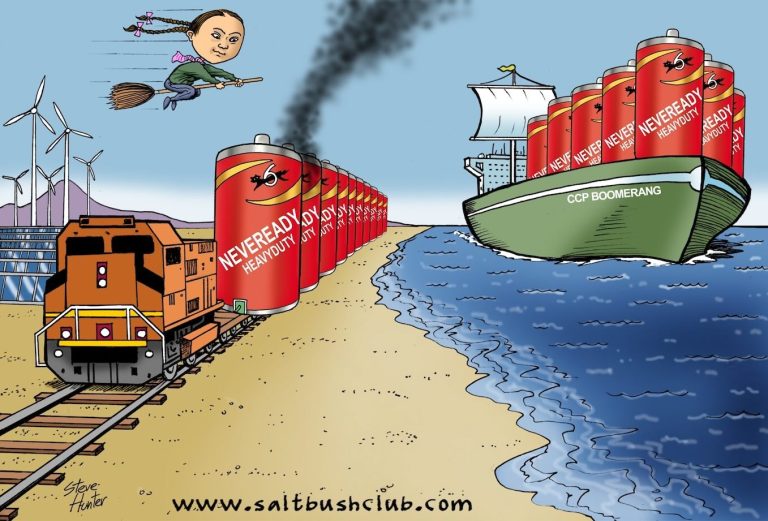
Both wind and solar energy have a fatal flaw – intermittency.
Solar generators don't run on moonlight – they weaken as the sun sets and stop when clouds obscure the sun. This happens at least once a day. [emphasis, links added]
But in the middle of the day most days, millions of solar panels pump so much electricity into the grid that prices plummet and no one makes money. After a big hailstorm, they stopped working.
Turbine generators are also intermittent – they stop whenever there is too little or too much wind. In a vast, flat land like Australia, wind droughts can affect large areas for days at a time.
This often happens when large amounts of cold air move over Australia: in colder weather, winds weaken and power demand increases. All of this makes our grid more volatile, more fragile, and more unstable. What should we do if it’s cloudy and windless all week?
Our green energy officials have the solution to green power woes—the “big battery.”
But big batteries bring more big problems—they have to be charged by the same intermittent green generator that keeps the lights onTrains are running and all electric cars, trucks and bulldozers have batteries charged.
If someone was stupid enough to build some power-hungry green hydrogen generator, they would also need more generating capacity and more backup batteries.
How long do we allow them to continue plowing our dollars into this bottomless green vortex?
Harvesting diluted intermittent wind and solar power from across a large continent like Australia and moving it to coastal cities and factories creates another “green” energy nightmare – Expensive and invasive power line spider webs are anathema to landowners, damage the environment, cause bushfires and are susceptible to damage from lightning, cyclones and vandalism.
They call them solar “farms” and wind “parks” – they're neither farms nor parks – they're huge, chaotic wind and solar farms. And these expensive “green” assets sit idle most of the time, producing no benefits.
It turns out that large batteries in cities pose a significant fire risk and no one wants to put them next door. Well our green “engineers” have another solution to these problems caused by their earlier “solution” – “Mobile Batteries” (this is a concern – no one knows where they are – maybe they will be disguised into Mr Whippy ice cream truck)?
Train entrepreneurs want to build “batteries on track” – a train full of batteries that stops next to a wind/solar plant until the batteries are full. The battery train then ambles toward the nearest city to unload power, ideally profiting from it.
They can also play the arbitrage market – buying supplementary power around noon and selling it at the highest price during breakfast and dinner hours, when the unreliable twins typically don't produce anything useful.
This has the added benefit of allowing coal and natural gas generators to break down faster by driving down peak prices. Once coal and natural gas are significantly reduced, battery packs can become truly lethal.
But battery packs could be the perfect answer to powering those power-hungry AI data centers. Let's start a pilot project and park the battery train next to the National Artificial Intelligence Center near CSIRO in Canberra.
A more ambitious idea is Project BBB – “Big Batteries on Boats”.
Here's how it works:
The Australian government placed an order with China to build a fleet of electric (sail-assisted, of course) boats full of batteries (and plenty of fire extinguishers).
The batteries are charged at Chinese ports using cheap coal-fired electricity. They then sail to Australian ports, where the electricity is fed into the grid whenever power prices rise or blackouts are imminent.
Australian mines can profit from iron ore used to build ships, rare minerals used to make batteries and any Australian coal used by Chinese power plants to recharge batteries.
The solution allows Australian politicians to brag about “net zero” Australian electricity at world conferencescan attract more visitors to our endangered industrial relics – the Coal Mine Museum and the Steam Generator Museum.
Of course, there's another danger with the BBB solution – some entrepreneurs might load their ships with nuclear generators and enough fuel to run them for decades.
Or they might even build a small nuclear reactor next to a closed coal-fired power plant and take advantage of all the existing power lines that are already in place.
Such dangerous thinking could well derail another of Queensland's green dreams – CopperString – a proposed $5 billion new 840km transmission line from Townsville to Mt Isa.
We're not sure which direction the power is expected to flow. They may not get there until the great copper mines in Mount Isa close.
Why not just launch a train of small nuclear bombs at Mount Isa?
Viv Forbes BScApp, FAusImm (Fellow of the Australian Institute of Mining and Metallurgical Resources), FSIA, is executive director of the Saltbush Club and founder of the Carbon Sense Alliance. He has no investments in or contracts with natural gas, coal or cement companies. But he has a diesel generator in his shed, a petrol-powered quad bike, a diesel tractor, a gas bubby and a stupid solar panel on the roof.
